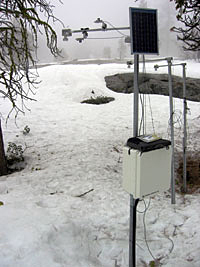
More than half of the water used in California for farming and drinking and other everyday uses comes by way of runoff from the Sierra Nevada, and gauging the amount of snow there and predicting how much runoff there will be is an annual rite that has a major trickledown effect of its own.
Currently, water managers physically measure the snow depth at a series of index sites, and they compare the results to those from past years to predict water availability and thus determine how much water will be allocated to farmers and communities. The data are limited and the predictions can have a high uncertainty, which leads to costly inefficiencies in the process.
That could all be changing soon, as Professor Roger Bales of the University of California, Merced — with help from UC Berkeley and the UC’s Center for Information Technology Research in the Interest of Society (CITRIS) — has designed a system that will use clusters of wireless sensors to provide more accurate measurements of snowpack depth, water storage in soil, stream flow and other important factors, and make that data available to the public in real time.
“In a more physically based approach to predictions, you start with learning how much snow is there,” Bales said. “Then you measure rainfall, model the timing of snowmelt and estimate how much water is used by trees and exits the system elsewhere.”
 The result could be a boon to a statewide farming industry that already totals $35 billion annually, according to the California Department of Food and Agriculture.
The result could be a boon to a statewide farming industry that already totals $35 billion annually, according to the California Department of Food and Agriculture.
Because of the limited information they have access to and the increasing variability of seasonal precipitation and temperature, Bales said, state water managers often allocate resources with the worst-case scenario in mind. If the actual runoff is better than expected, it can be too late for farmers who have to plan their crops based on initial allocation estimates.
“Water managers need to give conservative estimates on water availability,” Bales said. “They have to, given what they don’t know. If we reduce the uncertainty in their estimates in a way that people can use, we could pretty easily imagine adding tens to hundreds of millions of dollars to the state’s economy.”
In addition to improving the process by which water quantity is tracked and predicted, the data generated by these instrument clusters will provide an unprecedented resource for future research while acting as a test site for a system that could eventually be used for environmental observation all over the world.
 Frozen mountain water can be exceptionally difficult to measure and track throughout the year. Trekking to remote areas for snow surveys can be expensive and treacherous, and complicated topography and complex systems of snowfall, thaw, absorption and runoff make water storage calculations fuzzy.
Frozen mountain water can be exceptionally difficult to measure and track throughout the year. Trekking to remote areas for snow surveys can be expensive and treacherous, and complicated topography and complex systems of snowfall, thaw, absorption and runoff make water storage calculations fuzzy.
Bales, a mountain hydrologist, worked with UC Berkeley Professor Steven Glaser — known for his work with wireless sensor networks — on a prototype project at the Southern Sierra Critical Zone Observatory. The sensors are not laid out on a grid, but are instead strategically located at areas of differing elevation, canopy cover, soil type and other variables.
That prototype project logs data from 300 sensors covering more than 1 square kilometer in the southern Sierra. The next phase will see the establishment of about 25 clusters of instruments in the American River basin, which covers about 4,500 square kilometers above Folsom Dam and is the source of a significant fraction of the state’s water.
“We’ll have a network of local networks strategically placed to capture the geographical variability in the basin,” Bales said. “Then we’ll extrapolate all these water-cycle measurements for the whole basin.”






